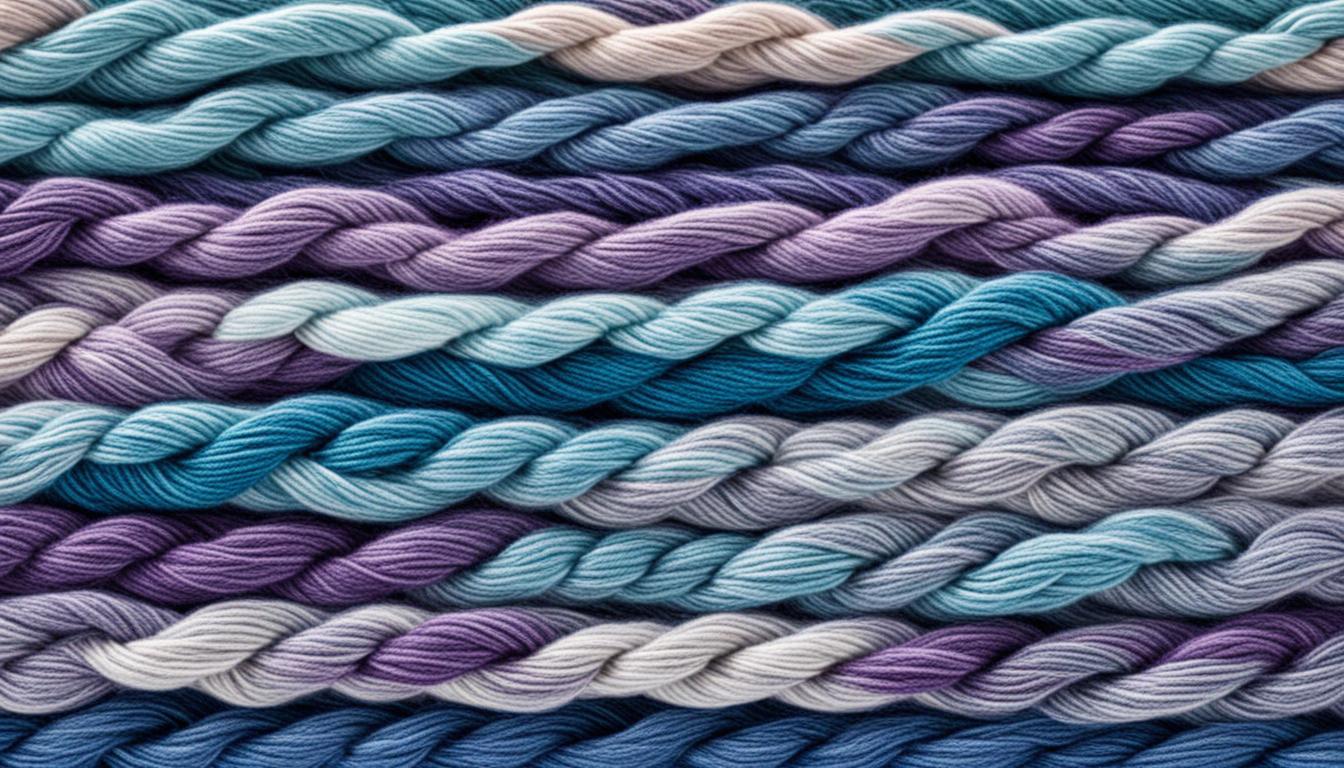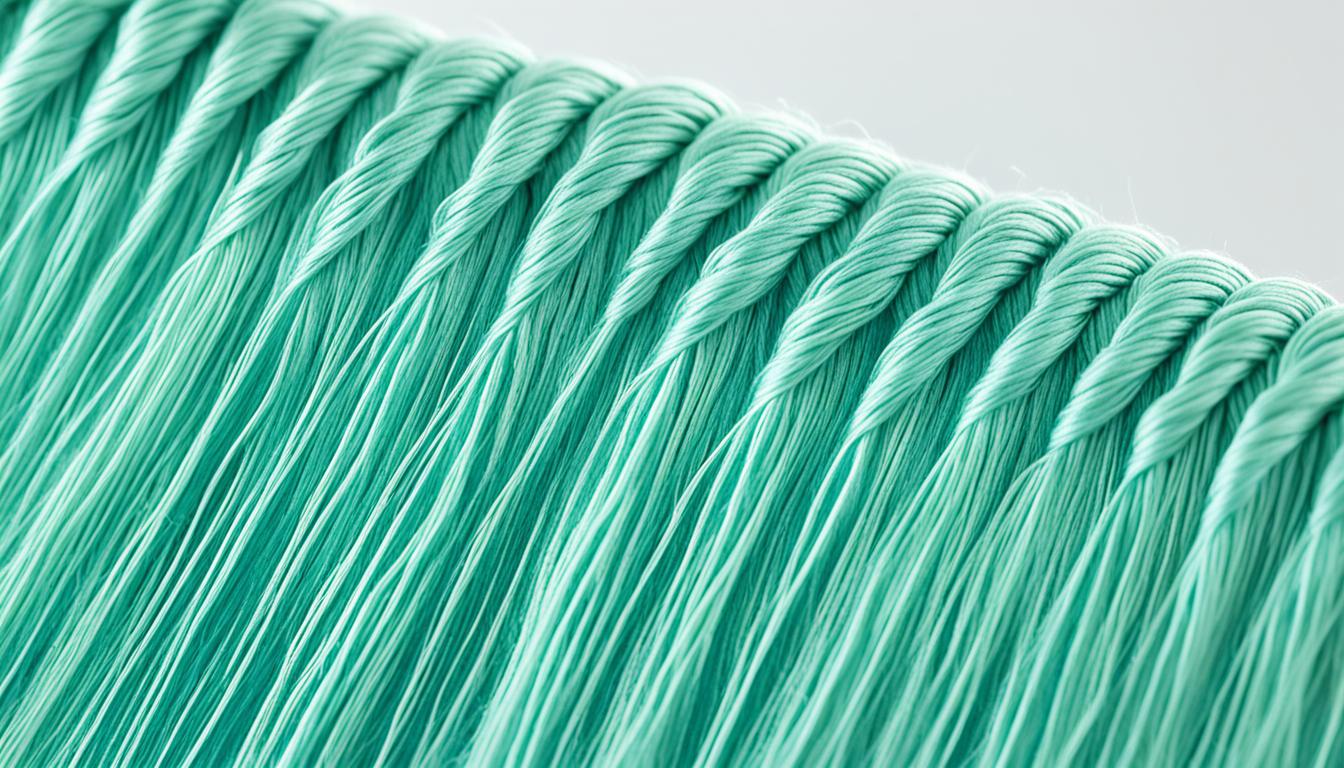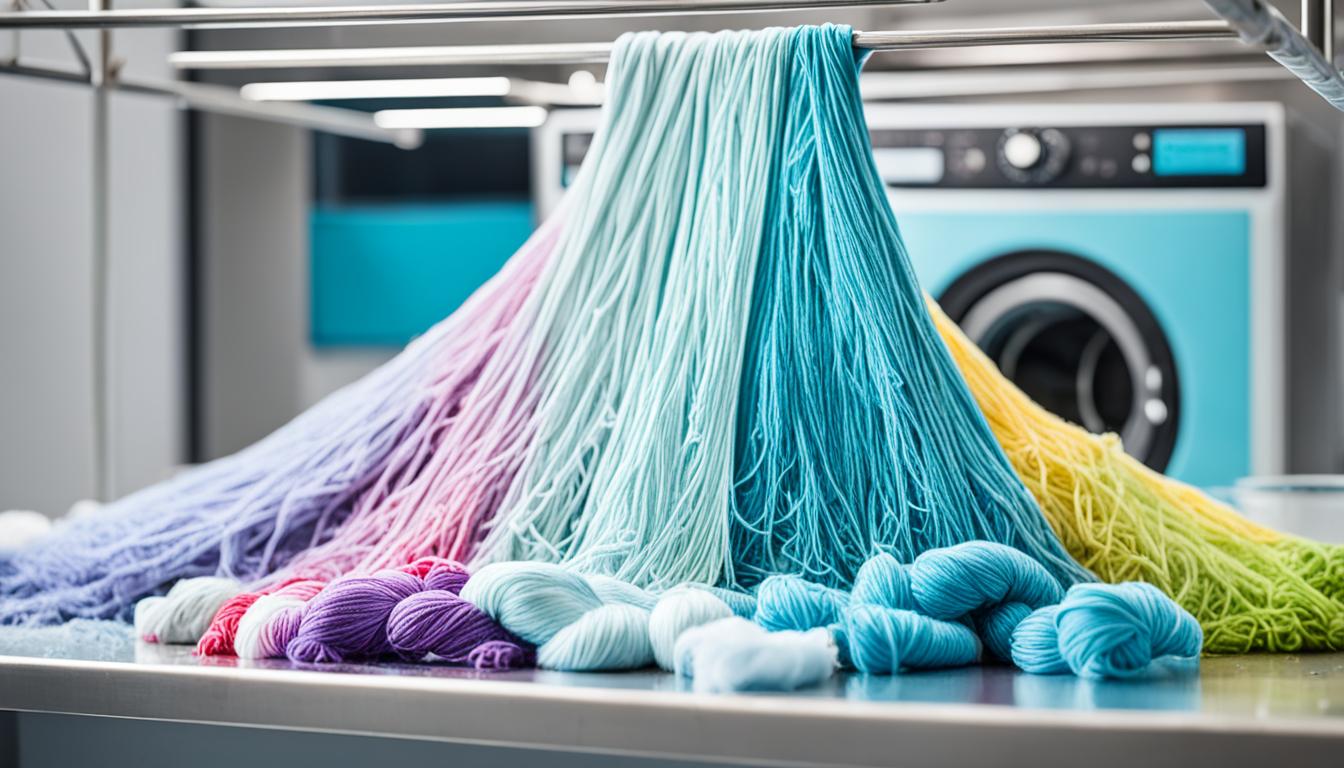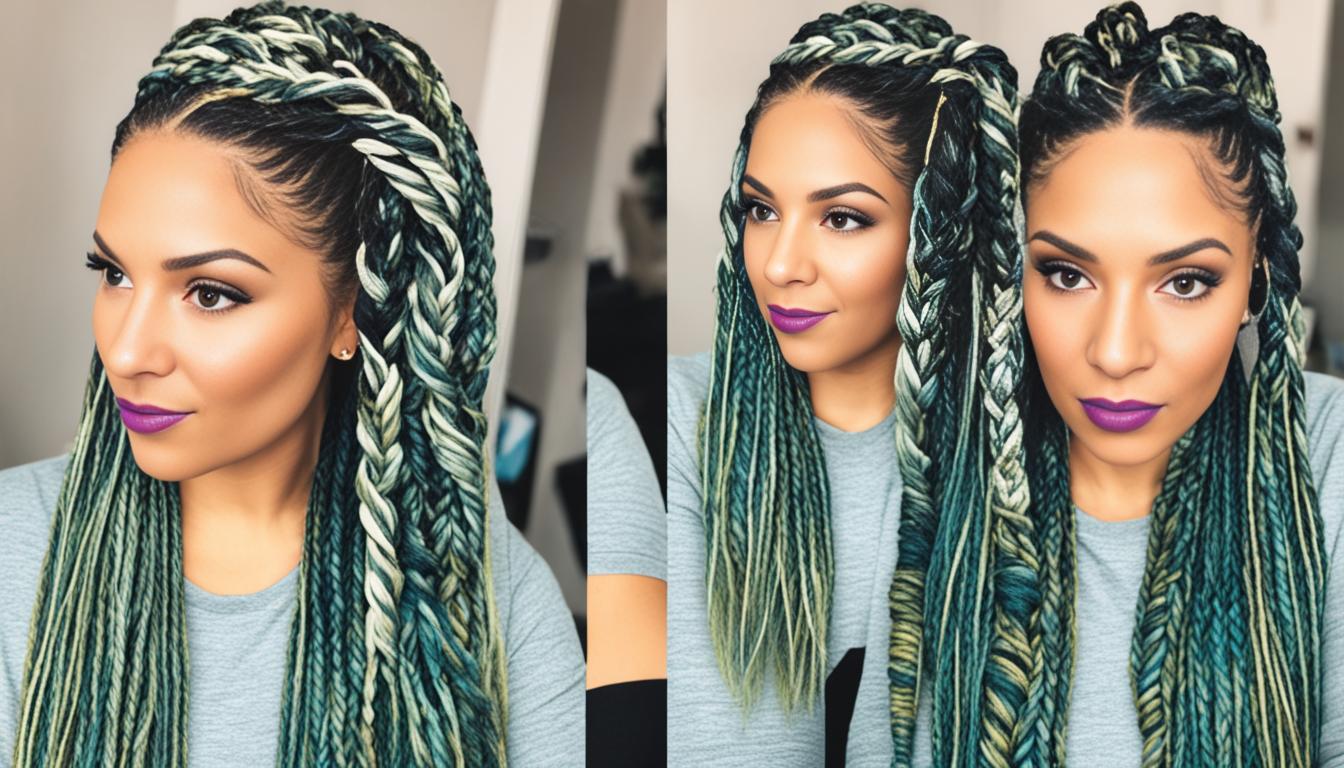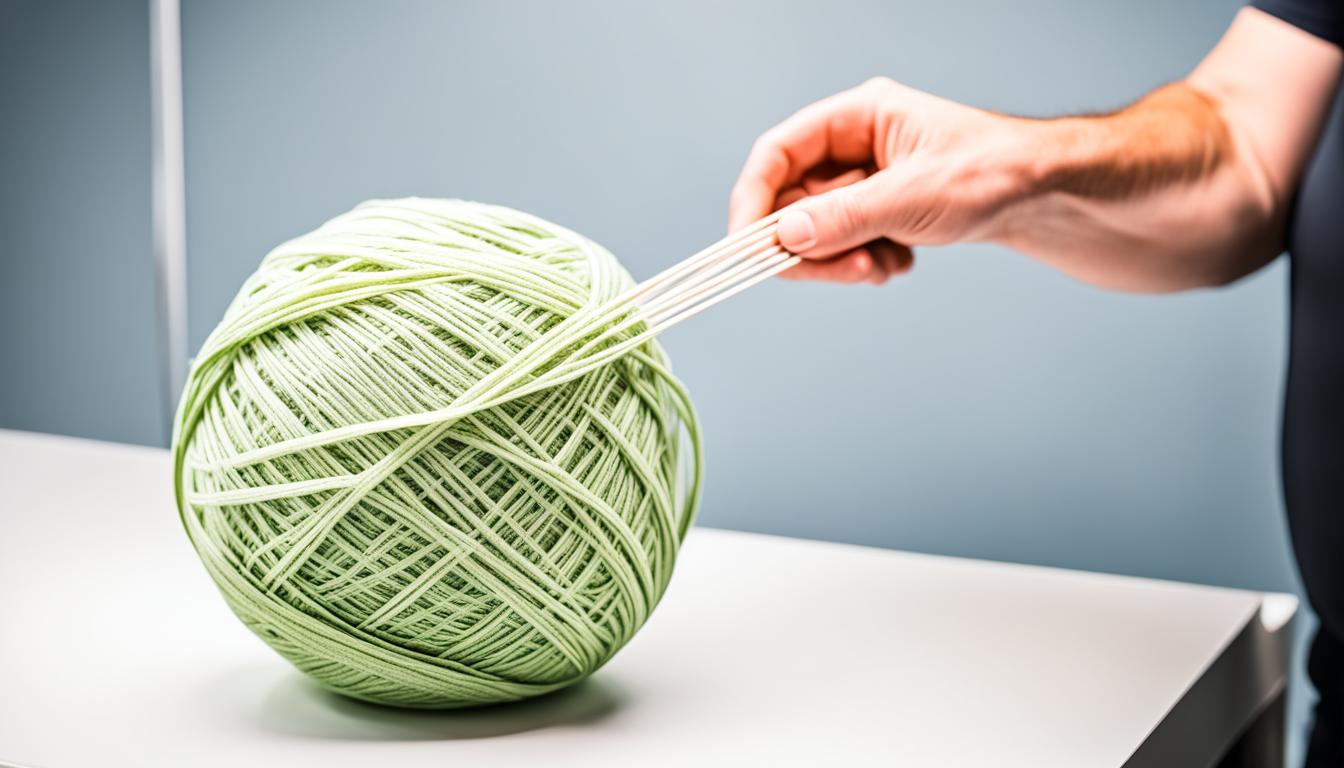Ever thought about how some fabrics achieve a beautiful blend of colors? Well, there’s a textile secret behind it all! Discover the mysteries of melange yarn, a captivating technique that produces one-of-a-kind and visually striking fabrics.
Melange yarn is a textile wonder that involves blending different colored fibers to produce a heathered or mottled appearance. But how is melange yarn made, and what are its properties and advantages? Let’s dive into the world of melange yarn and uncover its secrets.
Key Takeaways:
- Melange yarn is created by blending different colored fibers during the spinning process.
- It can be made from various materials such as cotton, polyester, and wool.
- Melange yarn offers aesthetic appeal, versatility, and enhanced texture in fabrics.
- The production process includes degreasing, bleaching, dyeing, water washing, and drying.
- Melange yarn can be suitable for both summer and winter seasons, depending on the type of fibers used and the weight of the fabric.
What Is Melange Fabric?
Melange fabric is a type of textile that is created by blending different colored fibers to produce a heathered or mottled appearance. The word “melange” translates to “mixture” or “medley,” accurately describing the varied and blended look of the fabric.
Melange fabric can be made from a variety of materials, including cotton, polyester, wool, or a blend of different fibers. The production process involves combining different colored fibers or yarns during the spinning process. This process results in a fabric with a unique and visually appealing appearance.
This fabric is widely used in the manufacturing of clothing, such as shirts and sweaters, due to its subtle and sophisticated aesthetic. It offers a versatile range of uses and is suitable for both casual and formal garments.
Melange fabric provides several advantages. Its blended appearance adds depth and texture to garments, ensuring a unique and visually interesting look. The fabric’s versatility allows it to be used in various styles and designs, making it a popular choice in the fashion industry.
The textural variation of melange fabric adds a tactile element, enhancing the overall feel and touch of the fabric. This unique feature sets it apart from solid-colored fabrics, giving it a distinct appeal.
Additionally, melange fabric has the ability to camouflage minor stains and signs of wear due to its heathered appearance, making it a practical choice for everyday clothing.
Melange fabric can be suitable for both summer and winter seasons. The choice of fibers used and the weight of the fabric determine its suitability for different weather conditions.
Creating melange fabric involves several steps in the production process. These include degreasing, bleaching, dyeing, water washing, and drying. These steps are essential in ensuring the quality and appearance of the final fabric.
Key Points:
- Melange fabric is created by blending different colored fibers.
- It can be made from various materials, such as cotton, polyester, wool, or fiber blends.
- Melange fabric offers a unique and visually appealing appearance.
- It is commonly used in the manufacturing of clothing for its versatility and aesthetic appeal.
- Melange fabric provides advantages such as unique appearance, versatility, and textural variation.
- It can be suitable for both summer and winter seasons, depending on the fibers used and the weight of the fabric.
- The production process of melange fabric involves degreasing, bleaching, dyeing, water washing, and drying.
The History of Melange Fabric
The history of melange fabric dates back to the early days of textile manufacturing when artisans began experimenting with blending different fibers to create unique patterns and hues in woven fabrics. The origins of melange fabric can be traced to the desire to achieve visually striking textiles that would captivate the eye.
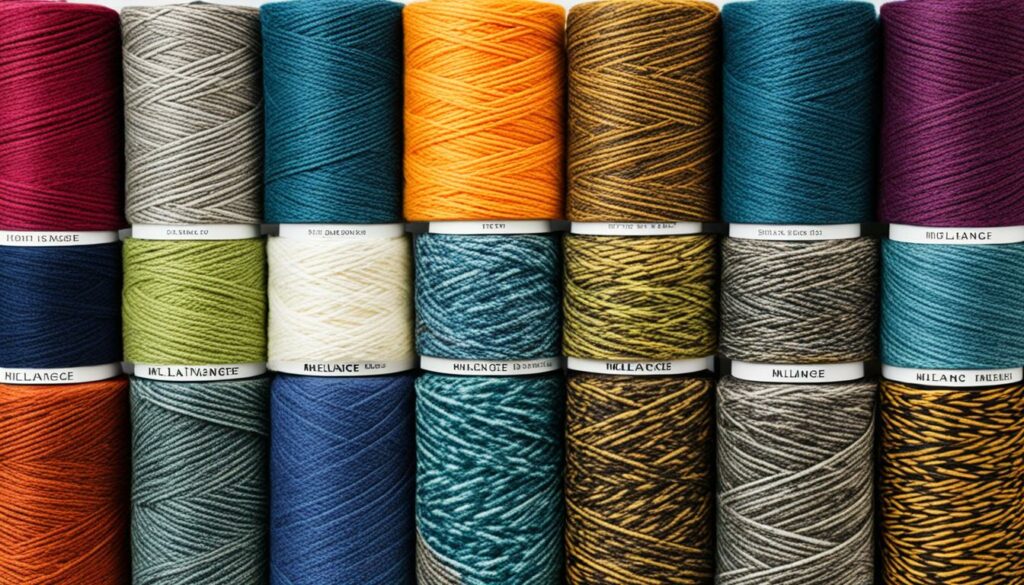
Textile weavers and spinners, centuries ago, began mixing fibers of varying colors, allowing for the creation of distinctive and complex patterns in their woven fabrics. As spinning and dyeing techniques evolved, artisans gained greater control over the color and texture of their textiles, leading to deliberate blending of differently colored fibers to achieve what is now known as the melange effect.
The Industrial Revolution in the 18th and 19th centuries brought significant advancements in textile manufacturing, enabling more precise control over yarn production. This revolutionized the production of melange fabrics, making it easier to create them on a larger scale.
“Melange fabrics gained popularity in the fashion industry as designers and consumers sought textiles that offered a unique, textured appearance.”
Today, melange fabrics are produced using a variety of fibers, both natural and synthetic. Designers incorporate melange fabrics into a wide range of clothing items, including shirts, sweaters, and more. The enduring popularity of melange fabrics can be attributed to their ability to add visual interest and a touch of sophistication to garments.
The Evolution of Melange Fabric Production
The production of melange fabric has come a long way since its humble beginnings. Traditional methods involved manually blending different colored fibers during the spinning process. However, technological advancements have made the production process more efficient and precise.
Modern melange fabric production involves several steps, including degreasing, bleaching, dyeing, water washing, and drying. Throughout these processes, fibers or yarns of different colors are intricately mixed and blended to achieve the desired heathered or mottled appearance.
Melange Fabric Trends
Melange fabrics have become a trend in the fashion industry, appealing to designers and consumers alike. The unique, multi-colored appearance of melange fabrics adds depth and character to garments, making them stand out in a sea of solid-colored textiles.
Designers have embraced melange fabrics for their ability to offer both visual interest and a touch of sophistication to their collections. The versatility of melange fabrics allows for creative expression in clothing design, enabling a wide range of color combinations and patterns.
| Benefits of Melange Fabric | Trends in Melange Fabric |
|---|---|
| Unique and distinctive appearance | Wide range of color combinations |
| Added depth and texture to garments | Incorporation into casual and formal wear |
| Versatility in design and style | Preference for heathered and mottled textures |
The popularity of melange fabrics has continued to grow due to their innate ability to complement different fashion styles and trends. As new techniques and materials emerge, melange fabrics remain a go-to choice for designers who wish to create garments that capture attention and offer a distinct visual appeal.
The Process of Melange Fabric
The production process of melange fabric involves blending different colored fibers or yarns to achieve a varied and mottled appearance. The specific steps of the process can vary depending on the type of fibers used and the desired characteristics of the final fabric.
Generally, the process includes the following steps:
- Degreasing: Removing any greasy substances or impurities from the fibers or yarns.
- Bleaching: Whitening the fibers or yarns to create a neutral base color.
- Alkali Washing: Treating the fibers or yarns with an alkali solution to improve their absorbency and prepare them for dyeing.
- Dye Selection: Choosing the appropriate dyes to achieve the desired color shades and effects.
- Dye Solution Preparation: Creating a dye solution by dissolving the selected dyes in water or other solvents.
- Dyeing: Immersing the preprocessed textiles in the dye solution and allowing them to absorb the dyes. This can be done through various methods such as vat dyeing, yarn dyeing, or piece dyeing.
- Water Washing: Removing excess dyes and chemicals from the fabric by rinsing it with water.
- Drying: Ensuring the fabric is thoroughly dried after the dyeing process, either through natural air-drying or using mechanical drying methods. This step helps the fabric maintain its shape and stability.
- Cutting, Sewing, and Finished Product Inspection: Once dried, the fabric is cut into samples and sewn together to make the final garment. Quality inspection is conducted to ensure compliance before packaging and leaving the factory.
The blending of different colored fibers is achieved through the spinning process, where fibers of different shades or dyed fibers are combined. This blending creates a cohesive melange effect throughout the fabric.
The dyeing process is a crucial step in creating melange fabric, as it determines the final colors and shades of the fabric. The preprocessed textiles are immersed in the dye solution and react with the dyes through heating or other methods. This allows the fibers to absorb the dyes and create the desired color variations and mottled appearance.
The water washing process is essential in removing excess dyes and chemicals from the fabric, ensuring its safety and quality. It helps to enhance the fabric’s appearance and overall feel.
The drying process is crucial to maintaining the shape and stability of the fabric. It ensures that the melange fabric is dry and ready for further processing and garment construction.
Throughout the entire production process, attention to detail and quality control is essential to ensure the final melange fabric meets the desired color, texture, and size requirements.
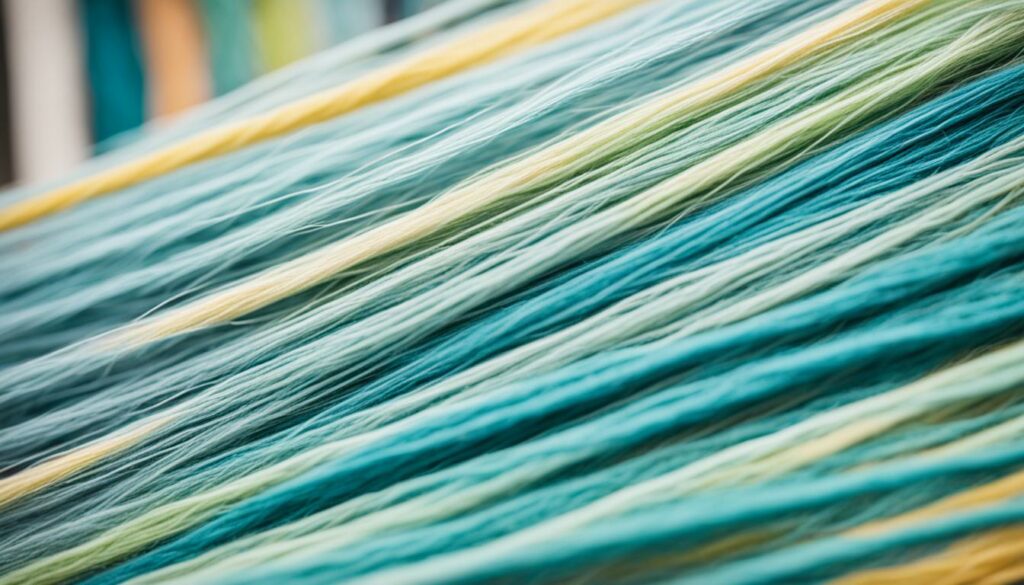
By following these production steps, the melange fabric achieves its unique appearance, combining different colored fibers to create a distinctive and visually appealing fabric.
Is Melange Fabric for Summer or Winter?
Melange fabric is a versatile choice that can be suitable for both summer and winter seasons, offering a range of options for different climates and personal preferences. The suitability of melange fabric for each season depends on the type of fibers used and the weight of the fabric. Let’s explore the characteristics that make melange fabric suitable for summer and winter.
Summer: Breathable and Lightweight Fabrics
In summer, when the temperatures rise and the sun shines brightly, it’s essential to choose fabrics that keep you cool and comfortable. Melange fabrics made from lighter-weight and breathable fibers, such as cotton or linen, are ideal for this season. These fabrics allow air circulation, preventing the body from overheating and providing a cooling effect. Melange cotton or linen shirts, for example, can be comfortable and stylish choices for summer casual wear.
Knit fabrics are also popular in summer due to their comfort and breathability. Melange knit fabrics, such as those used for T-shirts and polo shirts, offer excellent breathability and moisture-wicking properties, keeping you feeling fresh and comfortable even on hot and humid days.
Winter: Warmth and Insulation
In winter, when the temperatures drop and the air turns chilly, it’s essential to stay warm and cozy. Melange fabrics made from heavier or warmer fibers, such as wool or blends with synthetic insulating materials, provide the necessary warmth and insulation for colder seasons.
Melange wool or wool-blend fabrics are commonly used for winter sweaters and knitwear, providing both style and warmth. These fabrics are excellent for layering and can be paired with other garments to create stylish and cozy winter outfits. Heavier weight melange fabrics, like those used for cardigans or pullovers, offer extra insulation for colder days.
Transitional Seasons: Spring and Fall
Melange fabrics can also be suitable for transitional seasons like spring and fall, which often have fluctuating temperatures. Some melange fabrics offer a balance between breathability and warmth, making them ideal for these seasons. These fabrics provide versatility for wardrobe transitions between colder and warmer weather.
When choosing melange fabric for transitional seasons, consider factors like the weight of the fabric and the specific fibers used. Fabrics that combine breathable and insulating properties can provide both comfort and style during these transitional times of the year.
Overall, melange fabric offers a wide range of options for year-round wear, with suitable choices for different seasons and climates. Whether you’re seeking lightweight fabrics for summer or cozy materials for winter, melange fabric provides versatility, style, and comfort.
| Season | Melange Fabric Characteristics | Suggested Uses |
|---|---|---|
| Summer | Lightweight, breathable | Shirts, T-shirts, polo shirts |
| Winter | Warm, insulating | Sweaters, knitwear, layering pieces |
| Spring/Fall | Balanced breathability and warmth | Transition pieces, layering garments |
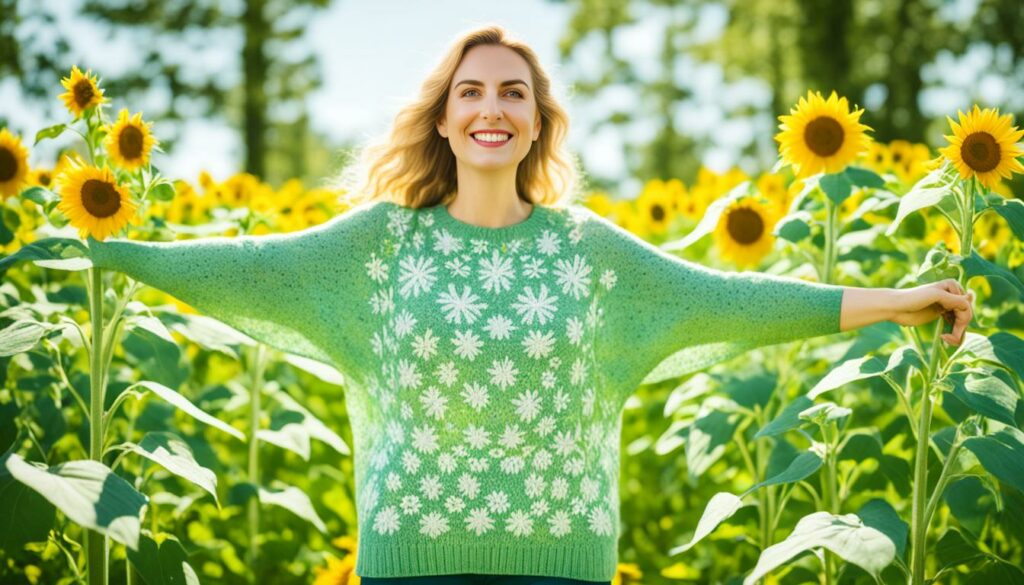
Explore the diverse range of melange fabric options and choose the perfect fabric for your seasonal wardrobe needs. Whether you’re dressing for warm summer days or chilly winter nights, melange fabric offers comfort, style, and versatility.
Advantages of Melange Fabric
Melange fabric has become increasingly popular in the textile and fashion industries due to its numerous advantages. From its aesthetic appeal to its versatility, there are several reasons why melange fabric is a favored choice for both designers and consumers alike.
One of the key advantages of melange fabric is its unique blended and mottled appearance. The combination of differently colored fibers creates a visually interesting and textured surface, making garments made from melange fabric stand out. This distinctive look adds depth and dimension to clothing, enhancing their overall aesthetic appeal.
Moreover, melange fabric is incredibly versatile in terms of its usage. It can be employed in a wide range of garment styles, from casual wear like T-shirts and sweaters to more formal or fashionable pieces. Whether it’s for everyday wear or special occasions, melange fabric offers a wide array of options for different clothing designs.
Another advantage of melange fabric is the textural variation it provides. The blending of different colored fibers creates a tactile appeal, enhancing the feel and touch of the fabric. This textural variation adds a luxurious and refined element to garments, making them more comfortable and enjoyable to wear.
| Advantages of Melange Fabric | Keywords |
|---|---|
| Aesthetic appeal | melange fabric aesthetic appeal |
| Versatility | melange fabric versatility |
| Textural variation | melange fabric textural variation |
| Camouflaging effects | melange fabric camouflaging effects |
| Fashion trend | melange fabric fashion trend |
| Color range | melange fabric color range |
In addition, the speckled or heathered appearance of melange fabric can help camouflage minor stains and signs of wear. This makes it a practical choice for everyday clothing, as it retains a fresh and clean look even with regular use.
Melange fabric has also been closely associated with contemporary fashion trends, making it a fashionable choice for those seeking modern and stylish clothing options. The unique visual appeal of melange fabric has made it a favored fabric in the fashion industry, allowing designers to create bold and innovative designs.
Lastly, melange fabric offers a wide range of colors to choose from, providing ample creative expression in clothing design. Designers can select from a variety of color options to complement different projects and moods, allowing for diverse and vibrant collections that cater to various preferences.
With its aesthetic appeal, versatility, textural variation, camouflaging effects, association with fashion trends, and an expansive color range, melange fabric continues to be a popular choice for both fashion-forward individuals and creative designers.
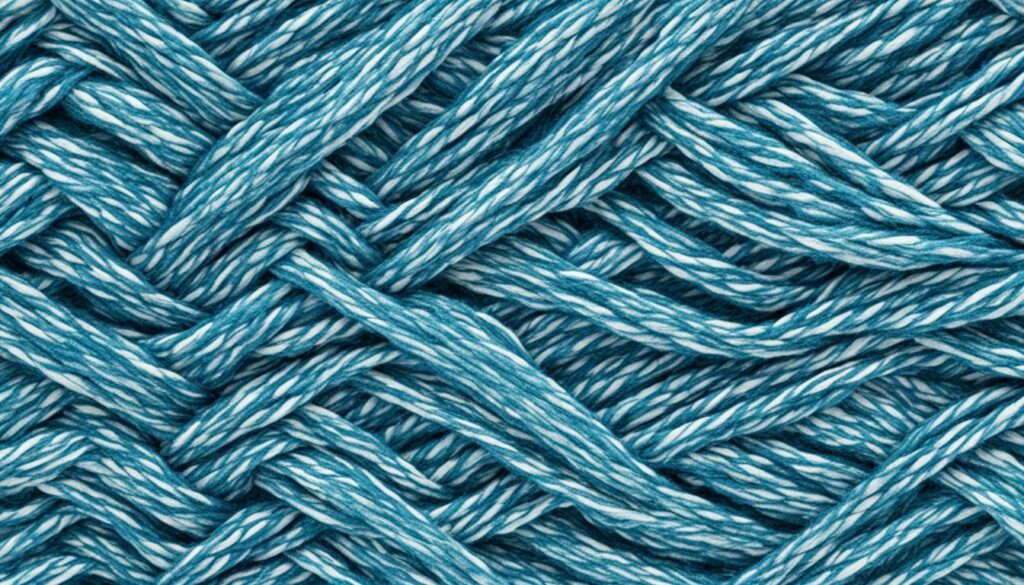
The Cultural Significance of Moroccan Rugs
Moroccan rugs hold significant cultural importance, representing the interwoven legacy of Berber craftsmanship and cultural exchanges. These handwoven textiles showcase the rich artistic traditions of the indigenous Berber tribes in Morocco.
The designs and motifs found in Moroccan rugs often reflect the cultural identity and spiritual beliefs of their creators. Each rug tells a unique story, capturing the essence of Moroccan culture and heritage. The patterns and symbolism woven into Moroccan rugs add depth and meaning, elevating them beyond mere decorative items.
The craftsmanship involved in creating these rugs is highly regarded and passed down through generations. Skilled artisans meticulously weave each thread, paying attention to every detail and ensuring the quality and beauty of the final product.
Each region in Morocco has its own distinct style and design language, reflecting the diverse beauty and artistic expressions found throughout the country. From the vibrant colors and intricate motifs of the Atlas Mountains to the earthy tones and abstract patterns of the Sahara Desert, Moroccan rugs represent the rich tapestry of Moroccan landscapes and cultures.
Beyond their aesthetic appeal, Moroccan rugs hold a deep cultural significance. They serve as touchstones of identity and unity for the communities that create them, preserving and celebrating centuries of tradition and heritage. These rugs are not merely functional objects but cherished pieces of art that connect present generations to their ancestors.
The Influence of Conquests and Trade on Rug History
The history of rugs is intertwined with conquests and trade, which have greatly influenced the art of rug making. This influence is evident in the cultural synthesis that is reflected in the unique patterns and motifs found in rugs. Through conquests and the establishment of trade routes, rugs became a global commodity, leading to the expansion of variety and styles in the market.
Persian and Oriental carpets, renowned for their exquisite craftsmanship, traveled along these trade routes, serving as symbols of intercultural exchange and diplomatic alliances. These interactions resulted in the infusion of new aesthetics and color palettes into traditional rug designs.
“Conquests and trade played a pivotal role in the evolution of rug design, creating a tapestry of global connections and influences.”
Middle Eastern influences, in particular, have left a mark on rug design. Arabic calligraphy and intricate Arabesque motifs are often incorporated into Middle Eastern carpets, showcasing the influence of Islamic art and culture.
Similarly, European influences have also made their way into the weaving looms of the East. European iconography, such as floral patterns and heraldic symbols, have found their place in rug designs, creating a fascinating blend of Eastern and Western artistic sensibilities.
The Interconnectedness of Different Cultures
The influence of conquests and trade on rug history underscores the interconnectedness of different cultures and civilizations. It reveals how artistic influences merge and adapt as they traverse borders, resulting in the rich tapestry of rug designs we see today.
These global connections have not only shaped rug history but also contributed to the evolution of artistic expressions and craftsmanship techniques. They serve as a testament to the enduring impact of cultural exchange and the indomitable human spirit that finds beauty in diversity.
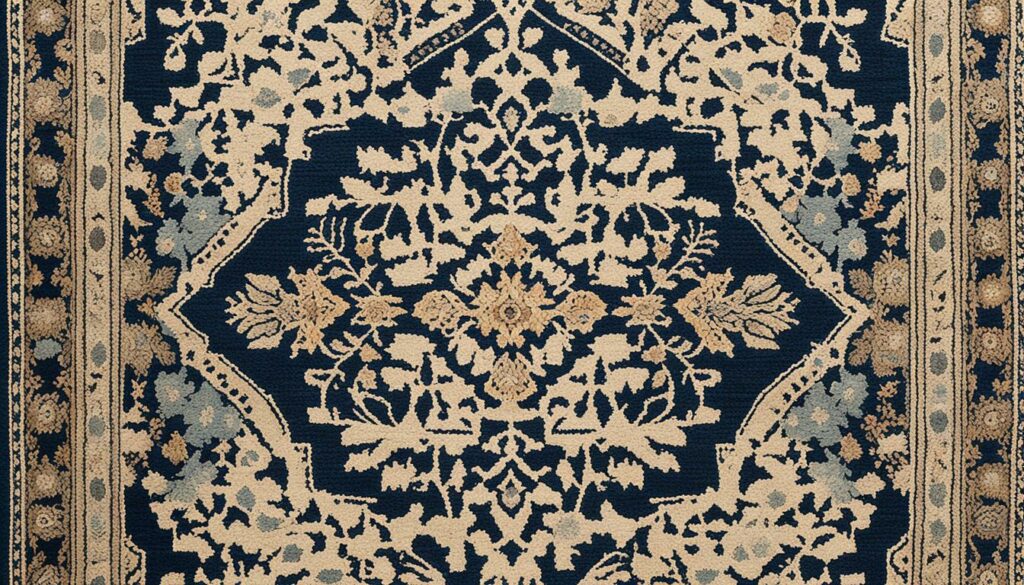
Conclusion
After exploring the world of melange yarn and fabric, we have discovered their unique visual characteristics and versatile applications in fashion and home decor. Melange fabric is created through the blending of different colored fibers, resulting in a fabric with a heathered or mottled appearance that offers a distinctive aesthetic appeal.
One of the remarkable qualities of melange fabric is its adaptability to different seasons. Depending on the type of fibers used and the weight of the fabric, melange fabric can be suitable for both summer and winter wear. Its versatility makes it a popular choice for various clothing styles and designs.
Turning our focus to the cultural significance of rugs, particularly Moroccan rugs, we find the embodiment of centuries of craftsmanship and artistic expression. The rich history of rug production is shaped by conquests and trade, leading to a diverse range of rugs designs and motifs that showcase the cultural synthesis and global connections central to their creation.
From melange yarn and fabric to cultural rugs, the world of textiles continues to captivate us with its beauty and storytelling capabilities. The intricate threads and patterns within melange yarn and traditional rugs serve as a testament to the creativity and artistry of textile production throughout history.
